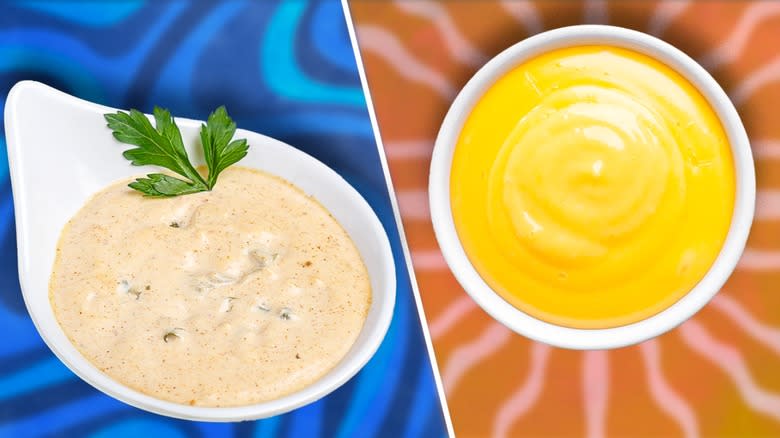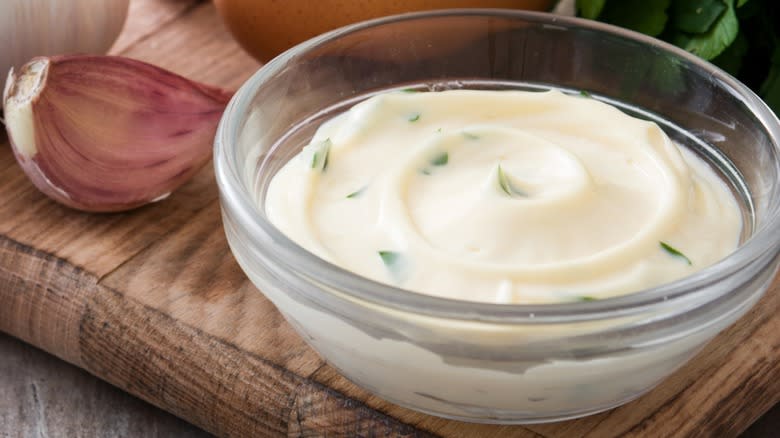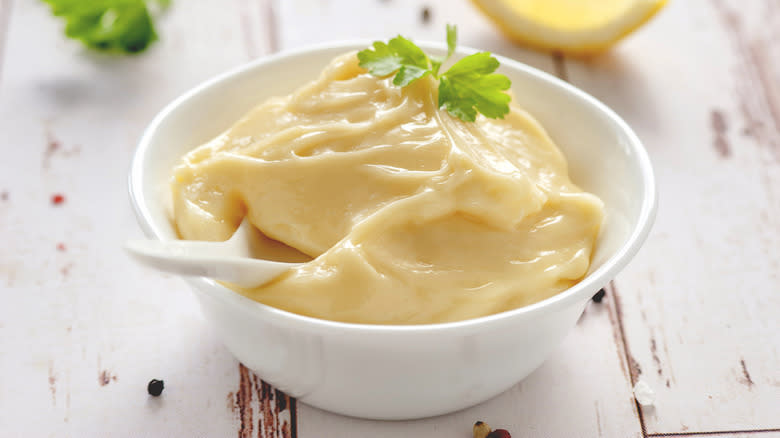What's The Difference Between Remoulade And Aioli?

While you've likely heard of both aioli and remoulade, the differences between the two sauces might not be immediately obvious. "But wait," you might be asking, "isn't aioli just garlicky mayonnaise?" This is neither a technically nor atmospherically incorrect summation. Whatever the etymology, the word "aioli" just sounds nicer on restaurant menus than "mayonnaise." So, then, what's remoulade?
You're likely to spy aioli on the menu at establishments from Balthazar in Manhattan to dive bars in Bedstuy. Remoulade, on the other hand, seems to be reserved for NOLA-style catfish joints and seafood-centric dining concepts. Why the saucy segregation? Both are thick, chilled sauces with oft-interchangeable uses and fancy-sounding names that make you look more like a gourmand than, say, ranch.
But remoulade and aioli are not to be discounted as "the same thing." Even just skin-deep, one is pink and one is yellow or white. Remoulade can be made from a myriad of ingredients, while aioli sticks to a pretty unwavering recipe. Also, while these sauces feature flavors that happen to pair well with a lot of the same foods, aioli and remoulade themselves taste wildly different.
Read more: The 20 Best Olive Oils For Cooking
What Is Aioli?

Aioli is a white or yellow sauce of both French and Mediterranean origin and remains a particularly prevalent ingredient in southern Provençal France and Catalonia, Spain. The name "aioli" comes from the French "ail," meaning garlic, and "oli," which is Provençal for oil. It literally translates to "garlic oil," which makes the name "garlic aioli" redundant. Traditional aioli consists of just olive oil and garlic, but the more common contemporary form of aioli emulsifies the oil into both mashed garlic and egg yolks for the rich, thick, lush mayonnaise-adjacent sauce fans know and love.
It also requires an acidic component, most commonly lemon juice or vinegar. Some French versions of aioli add extra lemon juice and a little Dijon mustard for a bolder, more complex flavor. The mustard also works as a binding agent, helping to hold the emulsion together. For a quick aioli fix, foodies can achieve a similar product by simply stirring garlic into store-bought mayonnaise.
Emulsification is kind of a big deal in the sauce world. It sounds intense and involved, but, simply put, emulsions are when you combine ingredients that tend to naturally separate. To get the molecules to stick together and meld into one cohesive sauce, the ingredients are combined one droplet at a time and smashed together after each addition with force -- in the case of aioli, with a mortar and pestle, food processor, or immersion blender.
What Is Remoulade?

Remoulade is French in origin, hailing from the Picardy region in northern France. The earliest recorded mention of remoulade in print comes from the "Oxford Companion to Food," which was published in the 1600s, and described early versions of the sauce as more of a flavorful broth than the thick, pink mixture fans know and love today. Remoulade is made from a variable blend of mayonnaise, mustard, shallots, capers, hot sauces, spices, and herbs.
Proto-versions might have also featured horseradish, as the name "remoulade" can be traced to the French "rémolat" or "ramolas," which mean horseradish. The sauce's inclusion of shallots and mustard bears a similarity to other French creations like beurre blanc and one of the five mother sauces, hollandaise. For a relatively easy prep, remoulade can be made by pulverizing the solid ingredients and combining them in a food processor or mashing by hand. (Remoulade includes mayonnaise, which is itself technically an emulsion, but the finished remoulade sauce can simply be stirred together in a bowl to combine.)
Thinner versions of remoulade even swap the mayonnaise for olive oil, yielding a texture more dressing-adjacent than saucy. The sauce has also taken on a life of its own in the French Quarter, dominating New Orleans po' boy sandwiches. When remoulade traveled from France to Louisiana, it melded into the melting pot of Creole cuisine, evolving with the influences of African and Caribbean culinary styles, providing a highly adaptable yet mouth-watering moisture element that could pair well with other bolder foods and spices.
Aioli Is Made With Fewer Ingredients

The primary difference that separates aioli and remoulade is their ingredients, and subsequently, their flavors and physical appearance. Traditional aioli may be just olive oil and garlic, but contemporary fans likely wouldn't recognize the sumptuous sauce without the addition of the creamy egg yolks. Whatever extra ingredients or spices might be tossed into the mix along the way, basic aioli combines just garlic, salt, egg yolks, lemon juice, and oil (often olive oil).
The olive oil lends a more luscious flavor in aioli compared to mayonnaise, which is made with a neutral oil like canola oil. This yields a sauce that is rich, creamy, tangy, and savory, ranging from off-white to golden yellow. Above all, aioli is pungent, wicked thick, and luscious. Remoulade, meanwhile, tastes savory, fresh, briny, and slightly spicy. Recipes for remoulade tend to vary regionally, whereas aioli remains largely the same. Louisiana foodies often add Tabasco, Louisiana Crystal hot sauce, and/or cayenne pepper to their remoulades.
Today, some versions of New Orleans remoulade include Creole mustard, which is made with horseradish, white vinegar, and mustard seeds for a sharper flavor. The pink-hued sauce sometimes also includes mild paprika and Worcestershire sauce. It can also feature other solid, pulverized ingredients like cornichons, anchovies, and capers for a more savory, umami flavor. The vinegar and herbs in French remoulade (namely tarragon and chervil) create a bolder, more multi-dimensional flavor profile compared to garlicky aioli.
Remoulade Has More Specific Uses

Both garlicky aioli and spicy remoulade make delicious sauces for fried seafood. Crab cakes, fish sticks, catfish nuggets, and tender poached shrimp can all be elevated with a lovin' spoonful of either sauce. But from there, the uses for these sauces diverge. This has as much to do with their unique flavors as their differing consistencies, with aioli being far denser than remoulade.
In France, aioli is a popular dip on crudité veggie trays. You can dip fries in it at the bar, or slam it on a heaping pile of roasted veggies and dig in. Smear it on a burger or a sandwich (like this Ratatouille-inspired eggplant panini), or use it as a salad dressing. Aioli makes a great creamy dressing for fried potatoes, or you could mash it directly into your next batch of mashed potatoes for an extra rich, creamy, and tangy bite. Folks often stir in a little sriracha, which makes for a killer moisture element in poke bowls and alongside chili oil cucumbers and spicy kimchi.
Per the conventions of traditional French cuisine, remoulade is a sauce typically paired with seafood, toting a more tartar sauce-adjacent utility. Along with seafood, remoulade is also commonly paired with cold meats and fried foods. You could also dip fried pickles in remoulade, or frizzle it over ribeye steaks hot off the grill. Not into meat? Use it to dress a summer plate of fried green tomatoes or artichoke hearts.
Read the original article on Tasting Table


